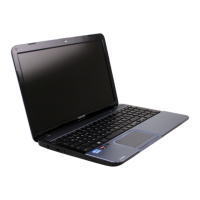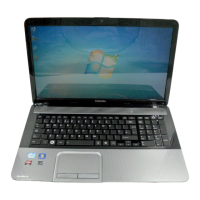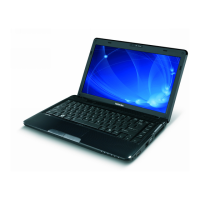
Do you have a question about the Toshiba Satellite L855D and is the answer not in the manual?
| Optical Drive | DVD SuperMulti Drive |
|---|---|
| Battery | 6-cell Lithium-Ion |
| Display Resolution | 1366 x 768 pixels |
| Processor | AMD A10-4600M |
| Storage | 1 TB HDD |
| Display | 15.6-inch |
| Graphics | AMD Radeon HD 7520G |
| Operating System | Windows 8 |
| Wireless | Wi-Fi 802.11b/g/n |
| Ports | USB 3.0, USB 2.0, HDMI, VGA, Ethernet |
| Weight | 2.3 kg |
| RAM | 4GB (up to 8GB) |
List of hardware and documentation items included with the computer.
Basic steps to start using the computer, including connecting AC and powering on.
Describes front, sides, back, and underside views of the computer.
Overview of the computer's internal hardware components like CPU and storage.
Explains touchpad and keyboard functions, indicators, and special keys.
Information on CD/DVD/Blu-ray drive types, formats, and usage.
Details on Wireless, LAN, and connecting devices like external monitors and HDMI.
Covers TOSHIBA VIDEO PLAYER, Blu-ray player, 3D playback, and sound system features.
Guidelines for handling, cleaning, and moving the computer, including heat dispersal.
Details TOSHIBA utilities like Peak Shift Control, PC Diagnostic Tool, Hi-Speed Start, Password Utility, HW Setup.
Explains pre-installed software like TOSHIBA Assist, ConfigFree, eco Utility, Disc Creator, Video Player.
Discusses features like Hot keys, power management, and automatic sleep/hibernation modes.
Instructions on using TOSHIBA Face Recognition and Password Utility.
Explains computer's power states and indicator lights (DC IN/Battery, Power).
Details battery types, care, charging, monitoring capacity, and maximizing battery life.
Information on extending battery life, replacing the battery pack, and its consumable nature.
Describes Shut Down, Hibernation, and Sleep modes and their configuration via Windows utilities.
Guidelines for diagnosing issues, including immediate stopping, recording observations, and analyzing problems.
Addresses issues with hardware like power, keyboard, display, HDD, optical drives, memory, pointing devices, USB, and sound.
Explains text formats, abbreviations, icons, keys, operations, messages, and terminology.
Provides the physical size specifications of the computer.
Details operating conditions like ambient temperature and humidity.
Lists the power specifications for the AC adaptor and computer.
Specifies wire size and current rating for AC power cords.
Lists various certification agencies for electrical products by country.
Explains factors affecting CPU performance and automatic shutdown conditions.
Outlines hardware and software requirements for 64-bit computing.
Discusses memory usage, limitations, and factors influencing battery life.
Covers HDD capacity, LCD characteristics, GPU performance, and Wireless LAN speed.
Details compliance and interoperability standards for Wireless LAN and Bluetooth.
Discusses electromagnetic energy emission and precautions for wireless device usage.
Provides country-specific restrictions and regulations for radio frequency usage.











